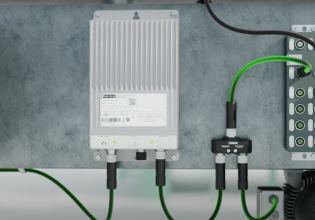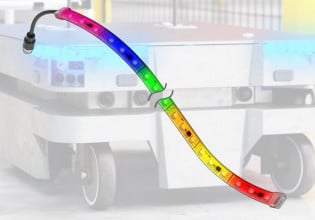ForwardX Robotics Flex 60-T: New Towing and Docking AMR for Cage Trollies
ForwardX Robotics has announced the Flex 60-T, a new AMR capable of moving carts and cage trollies up to 300kg to help with safety and efficiency for automated logistics operations.
Autonomous mobile robots, or AMRs, are essentially complete robotic cells on wheels. They are usually fully autonomous and can navigate through warehouses without the need for worker intervention. Generally used in logistics-type operations, they are often the workhorses in warehouse and shipping locations, taking stored product and bringing it to sorting stations, or other related tasks in the area of product movement.
AMRs In Modern Manufacturing and Logistics
Like many other robots, AMRs are useful in mundane, repetitive tasks, such as box retrieval and product movement within a plant or warehouse. The use of these types of robotic systems helps to save workers from injuries created by those repetitive tasks that are known for causing fatigue and injury. AMRs, in particular, are useful at saving workers from having to walk many miles a day to retrieve stored products or return products that need to be placed in the warehouse.
Many of the new AMR systems are able to be implemented into existing plant processes without the need for expensive plant infrastructure changes.
ForwardX Creates New Trolley-Hauling AMR
ForwardX Robotics is a global leader in AMRs with vision-based technology. They have recently been developing their latest addition to their AMR lineup: the Flex 60-T. The Flex 60-T features a state-of-the-art docking and towing system, meant to help with warehouse product and material movement. The flexible system can be used in many different industrial settings.

The Flex 60-T built by ForwardX can be used to maneuver standard wire carts. Image used courtesy of ForwardX
The system was designed to move cage trolleys for a superior method of material movement within the industrial environment. The setup was displayed at CeMAT Australia in July 2023, giving prospective customers a firsthand view of the new system. In order to create the Flex 60-T, ForwardX joined forces with Richmond Rolling Solutions to be an exclusive distribution partner for the system.
ForwardX has worked to create an AMR that addresses some of the major problems associated with the use of common cage-style trolleys in order to improve safety and efficiency. The development was a major step forward in worker safety by eliminating human labor for moving heavy carts around the warehouse. ForwardX has openly discussed how worker safety is a major concern in all of the work they do, and they focus on working condition improvement wherever they can.
Flex 60-T Features
The Flex 60-T has a payload rating allowing it to pull carts up to 300 kgs in weight, and is compatible with many carts, including both Australian Standard Z & A base roll cages. The system comes with multisensor fusion technology capable of detecting any obstacles it may come across in its day-to-day operation. The vision system entails the use of SLAM navigation and the use of 180-degree obstacle detection and avoidance.
The Flex 60-T is a new way for manufacturers to enhance plant efficiency, while simultaneously reducing the labor burden for their current workforce. It also helps to reduce costs through an improvement in efficiency. The system is also capable of utilizing AI technology for integration into modern Industry 4.0 infrastructure. ForwardX Robotics hopes that its latest AMR will be a big improvement to manufacturers and logistic operations that use standard wire basket cart systems.
Boosting the Supply Chain with Automation
During the past few years, the demand for products has increased while simultaneous bottlenecks in the supply chain and the workforce have shifted the conversation ever more toward warehouse automation. ForwardX is committed to providing high-quality products while raising the potential and quality of life for the robots’ human counterparts.






